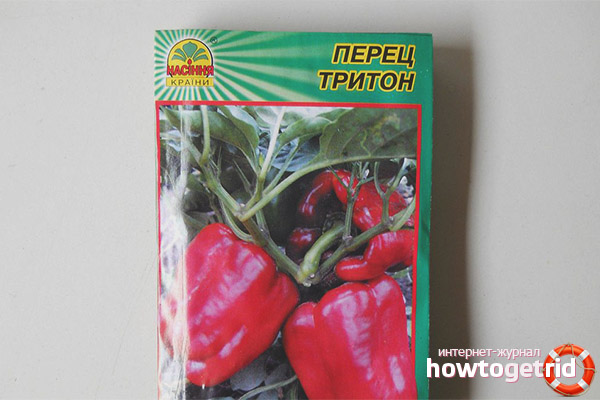The content of the article
Low-growing early ripe variety, has a fairly high yield. The plant is unpretentious in care. Harvesting can be carried out after 110 days from planting in open ground. Triton is a productive pepper for universal use. The plant is resistant to hot weather, tolerance to sunburn and good taste.
Grade description
The undoubted advantage of this variety is resistance to fusarium, apical decay. Fruits tolerate long-distance transportation. The pepper is thick-walled, juicy, very aromatic, fruit weight up to 300 g.
Fruits can be consumed fresh, used for canning.
Growing
First you need to calibrate the seeds. To do this, fill them with a glass of water, those that emerge, sift. Then carry out the hardening procedure. Place the seeds in a solution of non-concentrated potassium permanganate for fifteen minutes, in the future this will protect the plant from the appearance of fungal diseases.
Put the seeds in a damp cloth and let them swell. After a few hours, pour them into glasses. Do not use containers that are too large; the root system in peppers develops slowly. Seeding should not be too deep; it is enough to sprinkle the seeds with a 2-centimeter layer of fertile soil. A deeper seed placement will delay germination.
Many non-gardening gardeners make the mistake of starting pepper cultivation too early. In early spring, daylight hours are still too short. Without additional lighting, the seedlings are sluggish, in the future the plant will not bring the expected result. The seedlings are illuminated in the morning and evening for two hours.
Care
Do not forget that pepper feels extremely uncomfortable in windy places. Choose the most isolated places from the wind. In this regard, of course, greenhouse conditions are very suitable for pepper.
If the culture will be grown on poor soils, then complex fertilizers cannot be dispensed with. Especially for this purpose, you can make herbal infusion. To do this, fill a large amount of freshly cut grass with water, leave it alone for two weeks. Then strain the fermented infusion, water the plants under the root twice a day, morning and evening.
Bell pepper is very fond of moisture, does not tolerate drought. But culture does not favor an excess of water. Make sure that the soil does not dry out, but do not overdo it, because excess moisture can trigger an outbreak of fungal diseases.
Watering directly under the root, as otherwise there is a risk of sunburn. When watering, it is advisable to use warm, standing water with the addition of wood ash.
An important procedure is the formation of a bush. Do not forget about the removal of stepsons and fattening shoots.
Pasynkovka helps to direct all the energy of the plant to the development of the fruit, and not the vegetative mass of the bush. Despite the full benefits of the procedure, it is recommended to produce it no more than once a week. You can remove no more than three stepsons at a time, otherwise there is a risk of harming the plant.
Pepper has a fairly developed root system, so more than four plants should not be located on one square meter.
The crop plant Triton has oblong red fruits that do not crack during heat treatment and are well transported.
Video: the most early varieties of pepper










Submit